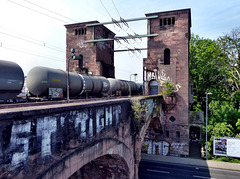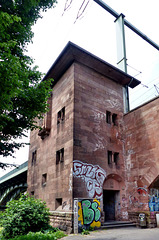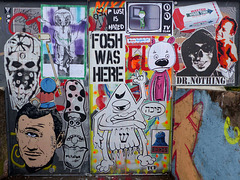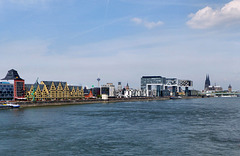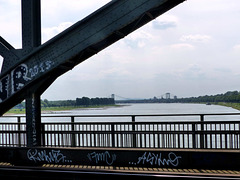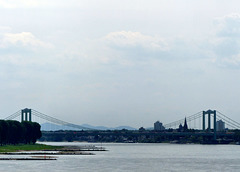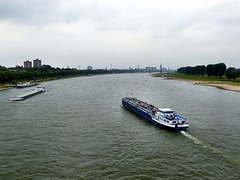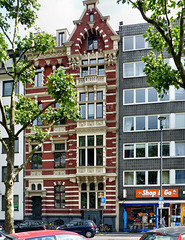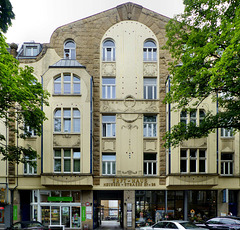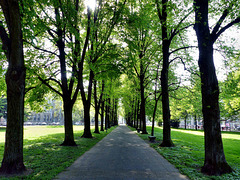
Cologne / Köln
Since 2017 I am very lucky and can live for some weeks in Cologne, stroll along the Rhine river and take many photos every year. - Thank you, Judith!
Cologne - Südbrücke
| |
|
Cologne is the fourth-largest city in Germany - and one of the oldest. A Germanic tribe, the Ubii, had a settlement here, this was named by the Romans "Oppidum Ubiorum". In 50 AD, the Romans founded "Colonia Claudia Ara Agrippinensium", the city then became the provincial capital of "Germania Inferior".
When I was in Cologne I learned, that it is possible to walk over all bridges, that cross the Rhine. I tried them all - and the Südbrücke ("South Bridge") now is my favourite bridge. There are no cars, as this two track bridge is used by freighttrains, pedestrians and cyclists.
The Südbrücke was built from 1906 to 1910. During the construction works in 1908 the middle arch collapsed, an accident in which eight workers were killed.
In WWII the bridge was largely destroyed in an air raid in January 1945. It got rebuilt an opened for operation again in 1950.
The steel structure has three spans (101,5 m + 165 m + 101,5 m) with a total length of 368 m and a width of 10.34 m. The pylons are built in a Neo Romanesque style and furnished with sculptural decorations.
Cologne - Südbrücke
| |
|
Cologne is the fourth-largest city in Germany - and one of the oldest. A Germanic tribe, the Ubii, had a settlement here, this was named by the Romans "Oppidum Ubiorum". In 50 AD, the Romans founded "Colonia Claudia Ara Agrippinensium", the city then became the provincial capital of "Germania Inferior".
When I was in Cologne I learned, that it is possible to walk over all bridges, that cross the Rhine. I tried them all - and the Südbrücke ("South Bridge") now is my favourite bridge. There are no cars, as this two track bridge is used by freighttrains, pedestrians and cyclists.
The Südbrücke was built from 1906 to 1910. During the construction works in 1908 the middle arch collapsed, an accident in which eight workers were killed.
In WWII the bridge was largely destroyed in an air raid in January 1945. It got rebuilt an opened for operation again in 1950.
The steel structure has three spans (101,5 m + 165 m + 101,5 m) with a total length of 368 m and a width of 10.34 m.
The pylons are built in a Neo Romanesque style and furnished with sculptural decorations.
Cologne - Südbrücke
| |
|
Cologne is the fourth-largest city in Germany - and one of the oldest. A Germanic tribe, the Ubii, had a settlement here, this was named by the Romans "Oppidum Ubiorum". In 50 AD, the Romans founded "Colonia Claudia Ara Agrippinensium", the city then became the provincial capital of "Germania Inferior".
When I was in Cologne I learned, that it is possible to walk over all bridges, that cross the Rhine. I tried them all - and the Südbrücke ("South Bridge") now is my favourite bridge. There are no cars, as this two track bridge is used by freighttrains, pedestrians and cyclists.
The Südbrücke was built from 1906 to 1910. During the construction works in 1908 the middle arch collapsed, an accident in which eight workers were killed.
In WWII the bridge was largely destroyed in an air raid in January 1945. It got rebuilt an opened for operation again in 1950.
The steel structure has three spans (101,5 m + 165 m + 101,5 m) with a total length of 368 m and a width of 10.34 m. The pylons are built in a Neo Romanesque style and furnished with sculptural decorations.
Cologne - Südbrücke
| |
|
Cologne is the fourth-largest city in Germany - and one of the oldest. A Germanic tribe, the Ubii, had a settlement here, this was named by the Romans "Oppidum Ubiorum". In 50 AD, the Romans founded "Colonia Claudia Ara Agrippinensium", the city then became the provincial capital of "Germania Inferior".
When I was in Cologne I learned, that it is possible to walk over all bridges, that cross the Rhine. I tried them all - and the Südbrücke ("South Bridge") now is my favourite bridge. There are no cars, as this two track bridge is used by freighttrains, pedestrians and cyclists.
The Südbrücke was built from 1906 to 1910. During the construction works in 1908 the middle arch collapsed, an accident in which eight workers were killed.
In WWII the bridge was largely destroyed in an air raid in January 1945. It got rebuilt an opened for operation again in 1950.
The steel structure has three spans (101,5 m + 165 m + 101,5 m) with a total length of 368 m and a width of 10.34 m. The pylons are built in a Neo Romanesque style and furnished with sculptural decorations.
The panorama of Cologne, seen from the Südbrücke. The "next" bridge is the green Severinsbrücke (completed in 1959). Right to the cathedral ("Kölner Dom") is "Groß St. Martin". To the left are the three Kranhäuser (crane houses), completed in 2008.
Cologne - Südbrücke
| |
|
Cologne is the fourth-largest city in Germany - and one of the oldest. A Germanic tribe, the Ubii, had a settlement here, this was named by the Romans "Oppidum Ubiorum". In 50 AD, the Romans founded "Colonia Claudia Ara Agrippinensium", the city then became the provincial capital of "Germania Inferior".
When I was in Cologne I learned, that it is possible to walk over all bridges, that cross the Rhine. I tried them all - and the Südbrücke ("South Bridge") now is my favourite bridge. There are no cars, as this two track bridge is used by freighttrains, pedestrians and cyclists.
The Südbrücke was built from 1906 to 1910. During the construction works in 1908 the middle arch collapsed, an accident in which eight workers were killed.
In WWII the bridge was largely destroyed in an air raid in January 1945. It got rebuilt an opened for operation again in 1950.
The steel structure has three spans (101,5 m + 165 m + 101,5 m) with a total length of 368 m and a width of 10.34 m. The pylons are built in a Neo Romanesque style and furnished with sculptural decorations.
The panorama of Cologne, seen from the Südbrücke. The "next" bridge is the green Severinsbrücke (completed in 1959). Right to the cathedral ("Kölner Dom") is "Groß St. Martin". To the left are the three Kranhäuser (crane houses), completed in 2008.
Cologne - Südbrücke
| |
|
Cologne is the fourth-largest city in Germany - and one of the oldest. A Germanic tribe, the Ubii, had a settlement here, this was named by the Romans "Oppidum Ubiorum". In 50 AD, the Romans founded "Colonia Claudia Ara Agrippinensium", the city then became the provincial capital of "Germania Inferior".
When I was in Cologne I learned, that it is possible to walk over all bridges, that cross the Rhine. I tried them all - and the Südbrücke ("South Bridge") now is my favourite bridge. There are no cars, as this two track bridge is used by freighttrains, pedestrians and cyclists.
The Südbrücke was built from 1906 to 1910. During the construction works in 1908 the middle arch collapsed, an accident in which eight workers were killed.
In WWII the bridge was largely destroyed in an air raid in January 1945. It got rebuilt an opened for operation again in 1950.
The steel structure has three spans (101,5 m + 165 m + 101,5 m) with a total length of 368 m and a width of 10.34 m. The pylons are built in a Neo Romanesque style and furnished with sculptural decorations.
Such a large structure of course attracts all kinds of "street-artists". This wall is completely covered with paste-ups.
Cologne - Panorama
| |
|
|
Cologne is the fourth-largest city in Germany - and one of the oldest. A Germanic tribe, the Ubii, had a settlement here, this was named by the Romans "Oppidum Ubiorum". In 50 AD, the Romans founded "Colonia Claudia Ara Agrippinensium", the city then became the provincial capital of "Germania Inferior".
Cologne´s panorama, seen from the Südbrücke ("South Bridge"). To the right is "Groß St. Martin" ("Great St. Martin") and the cathedral ("Kölner Dom"). The green "band" is part of the Severinsbrücke. Where the the three Kranhäuser ("crane houses", completed in 2008) and all the buildings left are, was the old harbour of Cologne. The yellow structures with the pointed gables are similar to the warehouses, that once lined the harbour.
Cologne - Rodenkirchener Brücke
| |
|
Cologne is the fourth-largest city in Germany - and one of the oldest. A Germanic tribe, the Ubii, had a settlement here, this was named by the Romans "Oppidum Ubiorum". In 50 AD, the Romans founded "Colonia Claudia Ara Agrippinensium", the city then became the provincial capital of "Germania Inferior".
The Rodenkirchener Brücke ("Rodenkirchen Bridge"), seen from the Südbrücke, is a suspension bridge, built from 1938 to 1941. The bridge was destroyed due to an airstrike in January 1945. Rebuilt from 1952 to 1954 the bridge is named after the district Rodenkirchen.
Cologne - Rodenkirchener Brücke
| |
|
|
Cologne is the fourth-largest city in Germany - and one of the oldest. A Germanic tribe, the Ubii, had a settlement here, this was named by the Romans "Oppidum Ubiorum". In 50 AD, the Romans founded "Colonia Claudia Ara Agrippinensium", the city then became the provincial capital of "Germania Inferior".
The Rodenkirchener Brücke ("Rodenkirchen Bridge") is a suspension bridge, built from 1938 to 1941. The bridge was destroyed due to an airstrike in January 1945. Rebuilt from 1952 to 1954 the bridge is named after the district Rodenkirchen. Because of the increasing traffic on the bridge (Autobahn 4) in 1990 it was expanded. The expansion was finished in 1995.
Cologne - Panorama
| |
|
Cologne is the fourth-largest city in Germany - and one of the oldest. A Germanic tribe, the Ubii, had a settlement here, this was named by the Romans "Oppidum Ubiorum". In 50 AD, the Romans founded "Colonia Claudia Ara Agrippinensium", the city then became the provincial capital of "Germania Inferior".
Cologne, seen from the The Rodenkirchener Brücke ("Rodenkirchen Bridge").
Cologne - Hansaring
| |
|
|
Cologne is the fourth-largest city in Germany - and one of the oldest. A Germanic tribe, the Ubii, had a settlement here, this was named by the Romans "Oppidum Ubiorum". In 50 AD, the Romans founded "Colonia Claudia Ara Agrippinensium", the city then became the provincial capital of "Germania Inferior".
--
During WWII Cologne was bombed in 262 separate air raids. The first ever 1,000 bomber raid by the RAF ("Operation Millenium") was conducted on Cologne in May 1942. In April 1945, when the American armee reached Cologne, the city was completely ruined. About 90% of all houses in the inner city were - gone. In 1939 Cologne had had a population of more than 700.00. In spring 1945 there were only about 40.000, living in the ruins. So the very most houses and facades in the ctity of Cologne are - young.
--
This well restored pre-war facade at Hansaring is embellished with two "Heinzelmännchen".
These house gnomes appear in an old Cologe tale. They once did all the work of the citizens during nighttime, so that the people in Cologne could be lazy during the day. According to the legend, this went on until a tailor's wife got so curious to see the gnomes that she scattered peas onto the floor of the workshop, so the gnomes slipped and fell. The "Heinzelmännchen", being infuriated, disappeared and never returned. From that night on, the citizens had to do all their work by themselves.
Cologne - Hansaring
| |
|
|
|
Cologne is the fourth-largest city in Germany - and one of the oldest. A Germanic tribe, the Ubii, had a settlement here, this was named by the Romans "Oppidum Ubiorum". In 50 AD, the Romans founded "Colonia Claudia Ara Agrippinensium", the city then became the provincial capital of "Germania Inferior".
Here is a closer look to the "Heinzelmännchen" (see previous upload for an overview and the story about the gnomes).
At first (from street level), I saw the house gnomes as weightlifters, but now they seem only to hold rolls of toilet paper - and watch the traffic below them.
There is a plaque under the gable. The house was erected in 1887, so there were no cars, when the "Heinzelmännder" took their seats.
Cologne - Neusser Straße
| |
|
Cologne is the fourth-largest city in Germany - and one of the oldest. A Germanic tribe, the Ubii, had a settlement here, this was named by the Romans "Oppidum Ubiorum". In 50 AD, the Romans founded "Colonia Claudia Ara Agrippinensium", the city then became the provincial capital of "Germania Inferior".
--
During WWII Cologne was bombed in 262 separate air raids. The first ever 1,000 bomber raid by the RAF ("Operation Millenium") was conducted on Cologne in May 1942. In April 1945, when the American armee reached Cologne, the city was completely ruined. About 90% of all houses in the inner city were - gone. In 1939 Cologne had had a population of more than 700.00. In spring 1945 there were only about 40.000, living in the ruins. So the very most houses and facades in the ctity of Cologne are - young.
--
The Neusser Straße of today follows the antique Roman road, that once connected "Colonia Claudia Ara Agrippinensium" (Cologne) with Novaesium (Neuss). During the Industrial Revolution of the 19th century, with its tremendous population increase, the city of Cologne grew along the existing roads. Just north of the medieval citywall the Agnesquarter (Agnesviertel) developed around the Neu-gothic Agnes Church (completed 1901). The impressive "Erft-Haus", seen here, was erected in 1905.
Cologne - Weidengasse
| |
|
Cologne is the fourth-largest city in Germany - and one of the oldest. A Germanic tribe, the Ubii, had a settlement here, this was named by the Romans "Oppidum Ubiorum". In 50 AD, the Romans founded "Colonia Claudia Ara Agrippinensium", the city then became the provincial capital of "Germania Inferior".
--
During WWII Cologne was bombed in 262 separate air raids. The first ever 1,000 bomber raid by the RAF ("Operation Millenium") was conducted on Cologne in May 1942. In April 1945, when the American armee reached Cologne, the city was completely ruined. About 90% of all houses in the inner city were - gone. In 1939 Cologne had had a population of more than 700.00. In spring 1945 there were only about 40.000, living in the ruins. So the very most houses and facades in the ctity of Cologne are - young.
--
The sign over the large portal of the narrow Neo-renaissance house reads "Wagenbauerei H. P. Hall", so behind the building once was a cartwright's workshop.
Cologne - Aachener Strasse
| |
|
|
Cologne is the fourth-largest city in Germany - and one of the oldest. A Germanic tribe, the Ubii, had a settlement here, this was named by the Romans "Oppidum Ubiorum". In 50 AD, the Romans founded "Colonia Claudia Ara Agrippinensium", the city then became the provincial capital of "Germania Inferior".
--
During WWII Cologne was bombed in 262 separate air raids. The first ever 1,000 bomber raid by the RAF ("Operation Millenium") was conducted on Cologne in May 1942. In April 1945, when the American armee reached Cologne, the city was completely ruined. About 90% of all houses in the inner city were - gone. In 1939 Cologne had had a population of more than 700.00. In spring 1945 there were only about 40.000, living in the ruins. So the very most houses and facades in the ctity of Cologne are - young.
--
The Aachener Strasse follows the antique Roman road "Via Belgica" that once passed through "Aquae granni" (Aachen) in Roman times, when necropolises lined these roads near the city. The well dressed twins, seen here, are only just about a century old. They contemplate about modern times.
Cologne - Severinsbrücke
| |
|
|
Cologne is the fourth-largest city in Germany - and one of the oldest. A Germanic tribe, the Ubii, had a settlement here, this was named by the Romans "Oppidum Ubiorum". In 50 AD, the Romans founded "Colonia Claudia Ara Agrippinensium", the city then became the provincial capital of "Germania Inferior".
The Severinsbrücke is a cable-stayed bridge was built from 1956 to 1959. It was Cologne´s first "new" bridge after WWII. It is 691 metres long and 29,50 metres wide. The steel is coated with chrome green colour, named "Kölner Brückengrün" ("Cologne-Brdige-Green"). Four of the eight bridges that cross the Rhine in Cologne are coated with "Kölner Brückengrün".
Cologne - Bonner Wall
| |
|
Cologne is the fourth-largest city in Germany - and one of the oldest. A Germanic tribe, the Ubii, had a settlement here, this was named by the Romans "Oppidum Ubiorum". In 50 AD, the Romans founded "Colonia Claudia Ara Agrippinensium", the city then became the provincial capital of "Germania Inferior".
There would probably not much protest, if Cologne would be declared the "Carnival Capital" of Germany. "Cologne Carnival" is called the 5th season , that is officially declared open at 11 minutes past 11 on the 11th of the 11th month November.
Between Fat Thursday (Weiberfastnacht) and Ash Wednesday (Aschermittwoch) the street-carnival runs high and reaches its climax Rose Monday (Rosenmontag) with the "Rose Monday Procession" (Rosenmontagszug). All through these days, Cologne folks go out masqueraded.
So there are special shops like this one, offering any kind of masks, wigs, hats, customes - red noses.
www.koelner-kostuemkiste.de
Kölle Alaaf!
Cologne - Ubierring
| |
|
Cologne is the fourth-largest city in Germany - and one of the oldest. A Germanic tribe, the Ubii, had a settlement here, this was named by the Romans "Oppidum Ubiorum". In 50 AD, the Romans founded "Colonia Claudia Ara Agrippinensium", the city then became the provincial capital of "Germania Inferior".
The Ubierring is the southern end of the Cologne Ring ("Kölner Ringe"), a semi-circular, about 6 km long urban boulevard, that encircles the old town of Cologne on the site of the former medieval city wall. The Cologne Ring is very busy four lane street, but here, near the embankment of the Rhine river, the Ubierring is very wide - and has this little park in the middle. A perfect place in spring!
Jump to top
RSS feed- Latest items - Subscribe to the latest items added to this album
- ipernity © 2007-2024
- Help & Contact
|
Club news
|
About ipernity
|
History |
ipernity Club & Prices |
Guide of good conduct
Donate | Group guidelines | Privacy policy | Terms of use | Statutes | In memoria -
Facebook
Twitter


